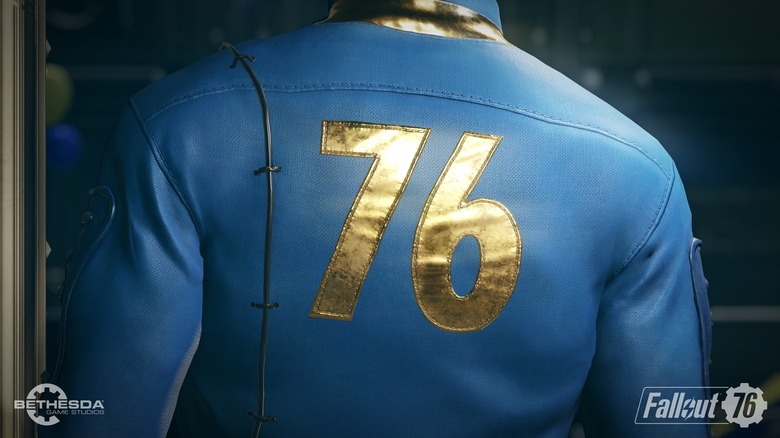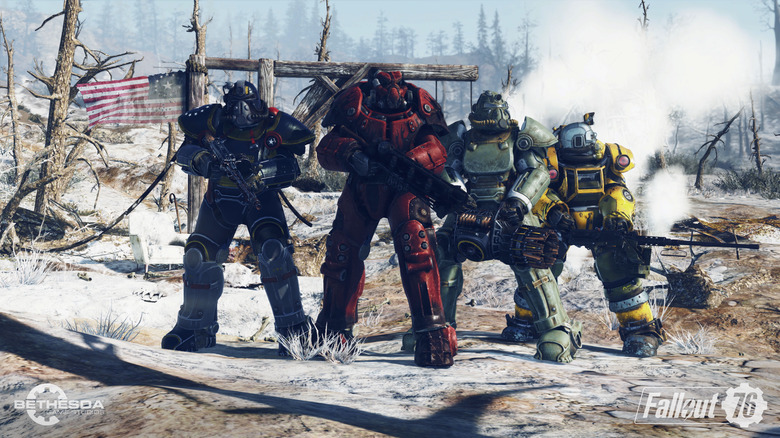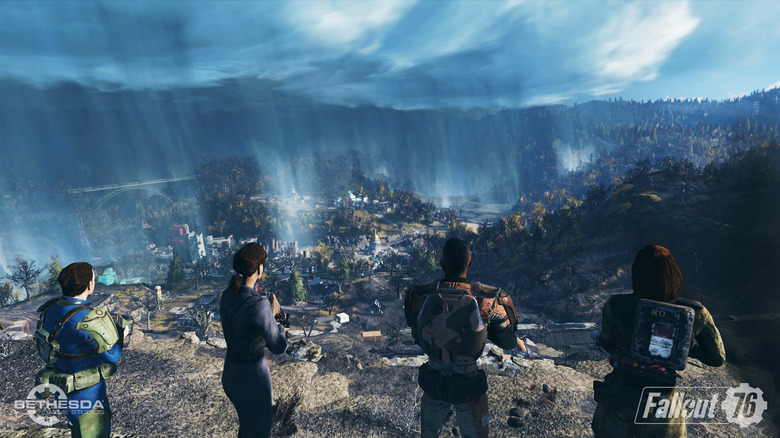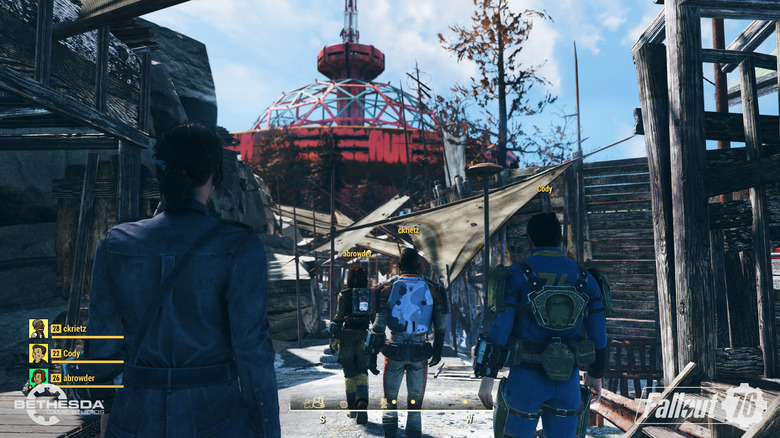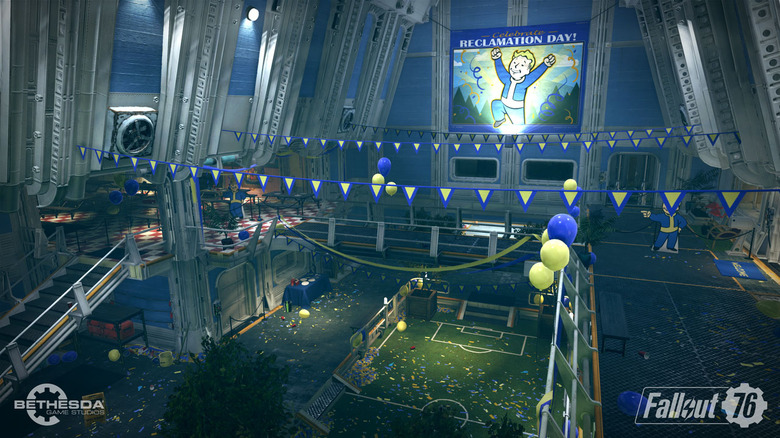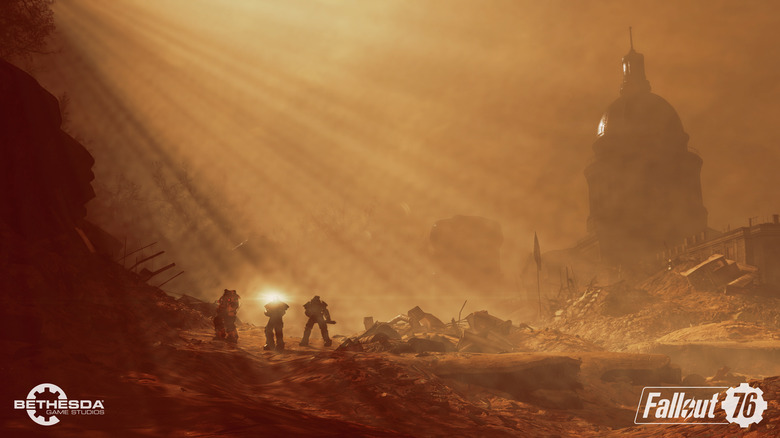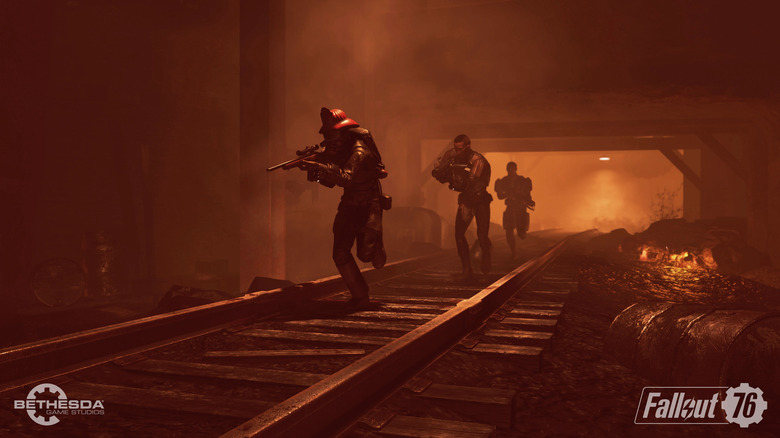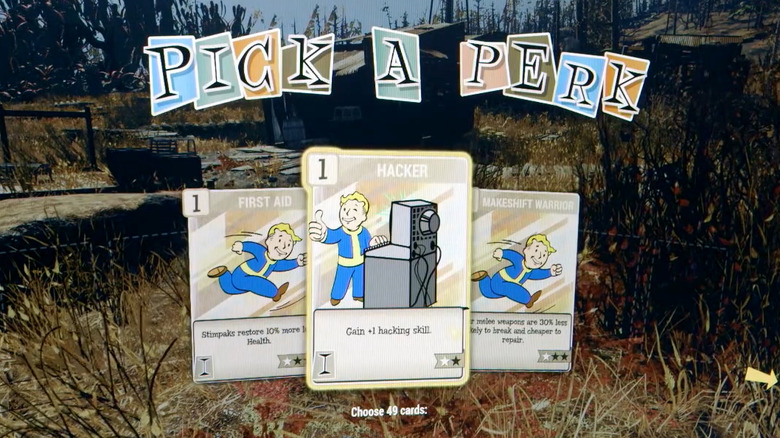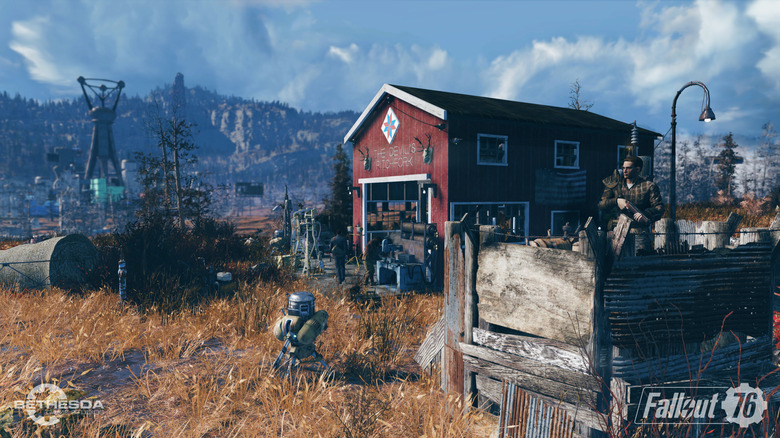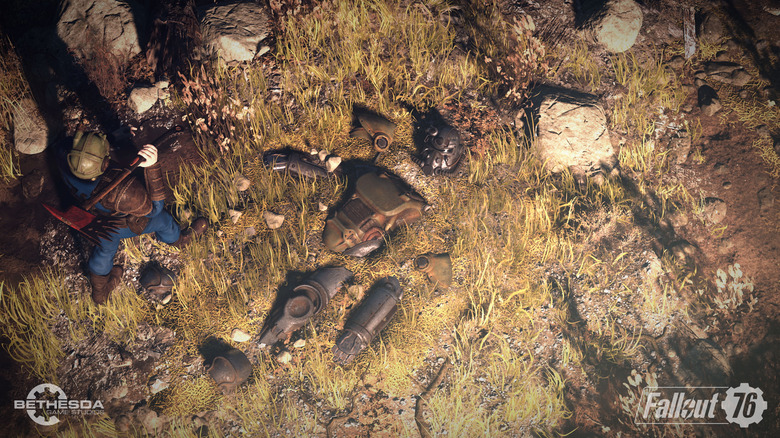What You May Not Know About Fallout 76
War never changes. But the Fallout franchise — while remaining loyal to a few principle philosophies of publisher Bethesda Studios — has definitely evolved over the years. From Bethesda's inaugural journey into a 3D wasteland for Fallout 3, through the gritty survival realism of Obsidian's "hardcore mode" in Fallout: New Vegas, to the settlement-building workshop sprawl of Fallout 4, everyone's favorite post-apocalyptic RPG has seen a number of changes — both mechanically and narratively — that have helped shaped the series for better or worse (depending on who you're talking to).
With the addition of multiplayer gameplay and a game map four times the size of Fallout 4, Bethesda's Fallout 76 promises to take the franchise into new and tantalizing territories. Following the game's official reveal and subsequent announcements during E3 2018, Fallout 76 has seen mixed reactions from both the delighted and the doubtful. Keen to clear up the haze of speculation and assuage any fears, Bethesda quickly offered up a bevy of information via interviews, documentaries, and direct marketing. You may very well know about the multiplayer and the huge West Virginian map, but here's a list of details you might have missed about Fallout 76.
76 began as the multiplayer design from Fallout 4
So where did this idea for a multiplayer entry in the Fallout series come from? Fortunately for us, Noclip provided a great deal of insight into the game's development with their web documentary The Making of Fallout 76, featuring an early, all-access look at the project's origins. According to Game Director Todd Howard, Fallout 76 is quite simply the unused multiplayer design from Fallout 4.
According to Noclip, the team at Bethesda began working on multiplayer elements for Fallout 4 as early as 2013, but eventually scrapped development of an online environment to focus entirely on the single-player experience.
The tide turned when parent company ZeniMax opened the Austin, Texas-based Battlecry Studios, whose team members boasted a wide range of experience in the online arena with titles like Ultima Online and Star Wars Galaxies. This team went to work on what would become Fallout 76 during the final days of Fallout 4's development, tweaking id Software's Quake net code and redesigning the player protocol from the ground up.
76 does away with dialogue-based NPC quests
Ever since the original isometric Fallout from Interplay Productions, the story of each game has relied upon heavy interaction with non-player characters through a robust dialogue system and an ensuing series of quests. The introduction of multiplayer to this environment has no doubt disrupted Bethesda's time-honored approach to crafting a compelling post-apocalyptic narrative. Todd Howard has been quick to address this facet of Fallout 76, affirming suspicions of core changes to these systems: "So the heavy NPC quest and dialogue system, like, it clearly doesn't have that."
Howard explained to GameSpot that player agency and event-based moments, rather than developer guidance, would ultimately shape the narrative of Fallout 76: "We want to let the players create story. There definitely is a story in this game. What happened to the people outside? Where are they? What are the new threats in the world? How do you solve that?" Pete Hines acknowledges this paradigm shift himself, but goes on to profess that "when you see it in action, and when you play it — when you feel it — it feels like you're playing a Fallout game."
You can play Fallout 76 solo
Despite the imminent focus on the game's multiplayer elements, Fallout 76 is definitely designed with the single-player experience in mind. So much, in fact, that Bethesda SVP of Global Marketing Pete Hines only plays it alone: "Whenever I play it, I play it always by myself. I don't group up with folks." Hines maintains that with or without other players in your game world, "you're still doing all of the things you would do in a Fallout game if it was an offline single-player game. Developing your character, going on quests, exploring the world."
With a lack of traditional NPC-based quests and narrative, developers were challenged to provide gameplay solutions for solo, co-op, and PvP players alike. This malleability can be attributed to one of Fallout 76's architectural shifts to the game engine: the quest data lives on the character, no longer the quest itself. And considering Bethesda's pedigree of award-winning single-player gameplay, it's no surprise (but a pleasant relief) that they'd want to preserve this compelling, often personal element for their enormous fanbase.
All the humans in Fallout 76 are real people
With a persistent multiplayer environment and the lack of a traditional quest-driven narrative, the onus of storytelling in Fallout 76 seems to rest squarely on the shoulders of its players. Fitting then, that this responsibility is a shared one. As Fallout 76 abandons the traditional element of quest-dispensing NPCs, it embraces the inclusion of additional player characters — each with their own unique motivations and impact on the game environment. Bethesda has clarified this aspect of gameplay with a simple solution: all the humans in Fallout 76 are real people.
This distinction not only eliminates confusion about whether or not encounters consist of human or AI enemies, it reinforces the notion that the unclaimed world that awaits players in Fallout 76 is perpetually up for grabs. Pete Hines describes these random encounters with other players with enthusiasm, suggesting that "maybe they're being super helpful, maybe wandering the world as a trader and just trading with people, maybe they're being a bad guy." For those of you lamenting the loss of classic wasteland enemies, fear not: to compensate for a potential lack of character representation and assorted hallmarks of the series, other narrative considerations have been made — including the addition of a new faction of intelligent ghouls called "The Scorched" which serve as the de facto Raider factions in Fallout 76.
Fallout 76 is a series prequel
As soon as the official teaser trailer hit the web, fan speculation about Fallout 76 was rampant, including theories on the game's timeline and why, precisely, that Pip-Boy on the unnamed survivor measured 500 rads on the dial. This attention to detail was rewarded when Todd Howard took the stage during Bethesda's official E3 2018 press conference and boldly proclaimed that "Fallout 76 is a prequel to all the other games, and it's our biggest one yet. It is four times the size of Fallout 4. Set in the hills of West Virginia, you are one of the first to emerge in an untamed and very different wasteland."
Pete Hines elaborated to GameSpot: "it is a sequel in that it is the next one in [the] Fallout [series], but we didn't call it Fallout 5 because it's not ... it's not the same. We are doing something different." As fans surmised, the October 2102 date on the Pip-Boy in the teaser also served to accentuate the nature of Fallout 76 as a prequel to the beloved series (25 years after the Great War started — and ended — on Saturday, October 23, 2077). By comparison, the events of Fallout 3 take place in the year 2277, 200 years after the nuclear holocaust that created the wasteland as we know it "today." And, just like Ol' Man Vault-Tec himself says in the teaser: "in Vault 76 our future begins."
Nukes have short term area effects on the world map
The sprawling world map of Fallout 76 sets a new size standard for the series, with a half-dozen distinct areas featuring distinct styles and difficulty levels. Verdant forests contrast with uninviting locales like "a hollowed out mountain top, soggy floodlands, festering toxic wastelands, swampy woods, and a colossal mountain range that dissects the entire map." But the wasteland ties it all together with the looming threat of nuclear radiation at every turn.
Traditionally, radioactive areas of the Fallout game map have been influenced by terrain features like toxic storage facilities, detonation of nuclear bombs, contaminated water zones, and the like. Fallout 76 pushes this idea further with the introduction of emergent moments and event-based nuclear explosions. But what does this mean for the game environment? Todd Howard explains that while nukes will have lasting effects, there is no real permanence to these earth-shattering strikes: "We're still messing with how long it lasts ... And the other thing is the world's really big, so wherever you nuke, it kills everything in that area if they didn't leave."
Howard confirms that a nuke will damage everything being built in its area of effect and will create a new, player-generated high-level radiation zone (with subsequent hazards). Furthermore, the six regions of Fallout 76 will respond differently to nukes, with each featuring their own unique flora and fauna following a high-level detonation.
Players can mutate from the high radiation
Along with closer proximity to the Great War, the advent of player-induced high-level radiation zones almost begs the question: how will exposure to increased radiation of the Fallout 76 timeline affect player characters? After riffing on the inverse relationship of Rads to Health in the previous games of the series, Fallout 76 Project Lead Jeff Gardiner summed up the introduction of player mutations: "In this game, the more rads you have, the more chances you get mutated ... they're almost like Traits from Fallout 1 and 2 where they have a plus and a minus."
The various benefits and penalties of this new mutation mechanic are curable, but players can also find ways to make them permanent if the boons happen to outweigh the hazards (although Gardiner describes this as "way late game stuff," so be prepared to do plenty of exploring before you find the perks you're looking for).
Prior to the reveal of Fallout 76, speculation ran high about whether or not players in a future Fallout title would be able to play as Ghouls or Super Mutants themselves. It seems like there was some truth to this, although the details remain to be seen. As Gardiner says, the mutations are "mostly gameplay. Some of them are visual, but they're mostly gameplay-side stuff that tweak your character a little."
76 features a retooled S.P.E.C.I.A.L. system using Perk Cards
With overhauls of many of the game's mechanical systems taking place, it's easy to understand that Fallout's traditional ability and skill subsets would undergo some slight changes as well. Indeed, Fallout 76 features a retooled version of the S.P.E.C.I.A.L ruleset utilizing a new system of "Perk Cards". As Noclip succinctly explains in their "Making of": "Each time you level up in Fallout 76 you get to pick a new perk card. There's a limited amount you can have active at one time, meaning that if you want to reroll your character's perks, you simply swap out your perk cards. You can also share perk cards within a party, meaning that teams of players can specialize to work together more efficiently."
Project Lead Jeff Gardiner confirmed immediate suspicions that Perk Cards will be able to improve crafting skills, offer new items and recipes to craft, and are tradeable with friends. Prior to the game's release, Bethesda is still exploring ways to offer the best experience for players using their Perk Cards proficiently, with an eye on features like robot Perk Card vendors and an increased focus on crafting with even more resources and recipes to find. Compared to the workshop and campfire creations in Fallout 4, there are "orders of magnitudes more."
You can relocate your entire camp via a "blueprint"
The popularity of building games like Minecraft and the flourishing tower defense genre had a profound impact on the gameplay of Fallout 4. From Sanctuary to Fort Independence, the construction and maintenance of survivor Settlements became an important (or, at the very least, omnipresent) part of the Commonwealth narrative; so we were all curious to see how these constructible camps would find their way in future Fallout games. But what happens when you're bouncing from server to server sharing the game world with 24 to 30 other players?
Fortunately, the wizards at Bethesda Game Studios have made it painfully easy to relocate the camps you've so painstakingly crafted. According to Jeff Gardiner, "when you move servers, if that space is available, your camp will just be there." And if your settlement can't be placed for some reason, if it's overlapping other terrain and can't be placed in a certain area for instance, "it will be packed up and blueprinted and you can place it somewhere else."
Anti-harassment in Fallout 76 PvP is a priority
Following the game's full reveal, one of the main concerns expressed by longtime fans of the series was how the introduction of a multiplayer element in 76 might compromise the traditional Fallout experience. Many players cited bad manners and potential griefing as impediments to an immersive and enjoyable RPG. But according to Todd Howard, that won't be an issue because "it feels like Fallout, [although] its loop and mood are very different. The other players are a system that we don't control, in a great way... Let 'em collide and where there's extra bad griefing or systems we have a number of levers in place. But that for me is where a lot of the drama is."
Pete Hines advocates allowing for that kind of PvP tension "but with systems in place that keep it from being abusive. So you can't be harassed by somebody who just keeps chasing you around the road and keeps killing you over and over again. The game literally doesn't allow that to happen to you ... Death isn't supposed to be a super negative thing." Gardiner also touched upon restrictions of workshop placement and the like to prevent griefing from and toward respawning players.
This promise of a fair and balanced multiplayer environment might be hard to swallow, but it's one we're willing to believe until Reclamation Day comes.

